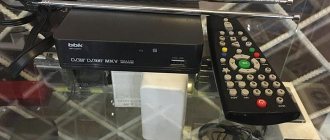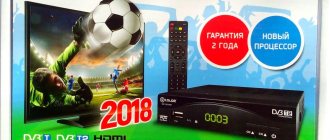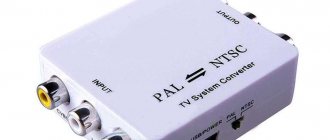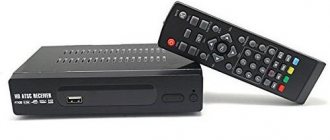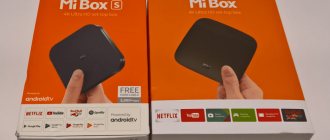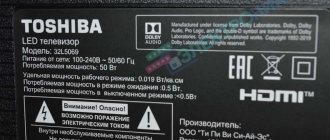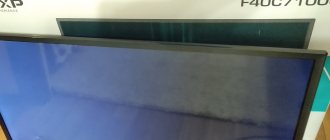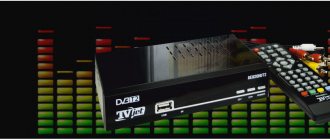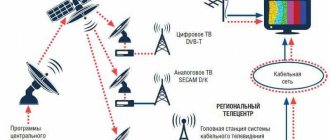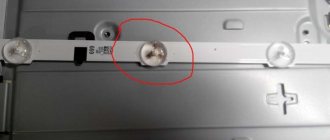Main characteristics
The BBK SMP015HDT2 black receiver supports all possible audio and video codecs. Plays video with high quality picture and sound. The dark gray receiver is designed to receive digital terrestrial TV and radio channels. The BBK SMP015HDT2 set-top box accepts signals from the DVB T and DVB T2 standards, as well as MPEG-2/MPEG-4. Has media player functions with support for MKV format.
Reception of channels is possible using a regular home antenna if the signal has the required level of quality.
The device can be used to watch TV channels in digital format and listen to radio using standard audio equipment - CRT and LCD plasma TVs, home theaters, speaker systems.
Functions:
- EPG (interactive program guide), with which you can view the program schedule at any time on the TV screen;
- program guide;
- teletext;
- HD TV support.
Equipment:
- receiver;
- remote control;
- AAA batteries;
- audio video cable;
- power adapter (unit);
- instruction manual with warranty card.
BBK SMP015HDT2
The release by the Chinese manufacturer BBK of the digital receiver BBK SMP015HDT2 , used for receiving free-to-air channels, is intended for consumers who want to buy a budget model at a low cost with the minimum necessary options for confident reception of programs. The device provides signal reception in DVB-T/T2 format with decoding of MPEG-2, MPEG-4 standards. The “heart” of the receiver is the modern MStar 7T01 processor, which effectively copes with the task of managing the device’s software.
Reception of over-the-air channels is carried out in the frequency range 174-230 MHz, 470-862 MHz. The technical equipment of the device allows you to display images on a digital TV screen in SD, HD standards with a resolution of 720p, 1080i, 1080p. The low-frequency signal of the composite output is capable of providing high-quality images when viewed on an analog TV.
The USB 2.0 interface built into the body of the set-top box guarantees the connection of external memory drives, which allows you to:
- Use the recording timer to program the order and number of channels to be recorded (PVR option).
- Set the necessary break when playing programs, fast forward the content in different directions (Time Shift option).
- Replace outdated software with new firmware.
- Play an extended list of audio/video files.
When the “media player” function is activated, the device is able to work with audio/video files in the following formats: AAC, HE-AAC, MP2, MP3, MPEG-1, MPEG-2, OGG, AVI, M2TS, MKV, MPEG, MPG, TS. An additional bonus is the ability to use an electronic program guide (EPG), subtitles, and teletext. Upon purchase, the user receives a kit consisting of a BBK SMP015HDT2 player, an external power adapter, a remote control with 2 AAA batteries, an RCA 3x3 cable, a user manual, and a warranty card.
The body design uses matte black plastic. The build quality leaves a good impression. The standard budget appearance of the device is “diluted” by the beveled surface of the top panel and elaborate ventilation holes on the side edges of the receiver, which makes it possible to distinguish the model from other manufacturers.
On the front panel there was only room for a USB 2.0 connector, an IR signal reception sensor, and a receiver operation indicator. All control buttons are on the remote control. The economical configuration of the rear panel includes an antenna input (RF IN), audio/video composite output jacks (RCA), an HDMI interface, and a port for connecting an external power supply.
Features BBK SMP015HDT2
- Availability of digital radio.
- Support for JPG graphic files.
- Dimensions: 98 x 16 x 4 mm.
- Weight: 300 gr.
Positive aspects of operation include modern design, stable reception when using an inexpensive antenna, and slight heating of the case during prolonged operation. The overall impression is spoiled by the small “range” of the remote control, overload of the remote control with small buttons, lack of high-frequency output (RF OUT), unfinished menu interface
Multimedia capabilities
A media player is a multimedia player. Its main purpose is to play content (audio, video, photos) from external media, PVR recordings. The BBK SMP015HDT2 receiver has all the necessary functions to configure playback parameters.
Setting up a media player
The operation of the device is simple. The main menu is the “Media Player” menu. To connect an external USB storage device, the TV tuner has a corresponding socket (USB port).
The buttons on the remote control (color and digital) work according to the information on the screen.
The number button “5” is designed to move between submenus.
The “Media Player” menu includes the “PVR” item - for playing video recordings made using this function.
In the “Music”, “Image” and “Video” sections, you can use the “6” key to sort audio tracks and images, and use the “7” key to select your preferred playback modes.
Instructions
The system setup menu contains the following items:
- setting the language in the menu, audio and teletext;
- selection of video input and image format;
- selecting the type of audio signal transmission via HDMI;
- setting the current date and time;
- adjusting the brightness, contrast, saturation and hue of the image;
- parental control;
- receiver software update;
- Safely remove USB storage device.
To clarify information about the frequency channel in a specific region, you need to contact the “Russian Television and Radio Broadcasting Network” by phone: 8-800-220-20-02.
Bbk smp016hdt2 how to set up
The transition from analog television broadcasting to digital DVB-T2, adopted as a federal standard in the Russian Federation, influenced not only the computer TV tuner industry. The fleet of TVs either without support for digital terrestrial broadcasting or with support for the first version of DVB-T turned out to be more than impressive, while many models simply did not have time to become obsolete in terms of diagonals and resolutions. A solution was found quite quickly, they became stand-alone TV tuners (in the future we will use the established term “receivers”), connected to TVs, usually via HDMI or a composite interface, less often supporting SCART (optional with RGB), while the retail price of such devices allows us to consider them accessible even in modern conditions of the domestic market.
BBK Electronics was among the first manufacturers to present such solutions, one of which with the heavy name BBK SMP137HDT2, based on the current chipset, we will consider further in the text.
Contents of delivery
The compact box has a traditional BBK blue and white color scheme, with explanatory inscriptions localized.
In addition to the receiver itself, the kit includes:
- remote control;
- 3 RCA - 3 RCA composite cable for analog video and audio connections;
- user guide.
Design and specifications
The manufacturer claims the following features of the BBK SMP137HDT2:
- DVB-T/DVB-T2 support;
- frequency range - 174-230 MHz (VHF), 470-862 MHz (UHF);
- rated power consumption - 8 W;
- input signal level - −75 - 20 dB mW;
- video decoder - MPEG-1, MPEG-2, MPEG-4 HD, H.264;
- audio decoder - MPEG-1, MPEG-2 (Layer I/II), MP3, AC-3, AAC-LC, HE-AAC;
- input stream - up to 40 Mbit/s;
- image format - 4:3/16:9;
- audio formats - MPEG Layer I&II, 32/44.1/48 kHz;
- electronic schedule of EPG channels;
- delayed viewing mode TimeShift;
- video recording function (PVR);
- JPEG support;
- USB 2.0 port for connecting external USB-compatible devices;
- support for MKV (Matroska) and TS containers;
- Dolby Digital support.
The device is available in two colors - Black and Dark Grey, the second option was tested. BBK SMP137HDT2 is a compact (device dimensions 174x158x42 mm, weight 370 g) parallelepiped with rounded corners. On the front panel, in addition to the name and several logos, there is a two-color (red in standby mode, green during operation) LED indicator and a USB port.
The rear panel contains an IEC antenna connector, an HDMI connector, and three RCA connectors for composite video and stereo audio.
The receiver has a built-in power supply; the cable cannot be disconnected.
On the bottom you can see ventilation holes and 4 legs, 2 plastic and 2 rubber.
The sticker informs you about the version number 2.0.
Alas, the retail nature of the test sample did not allow us to photograph the printed circuit board, so we will limit ourselves to listing the microcircuits used.
The basis of the BBK SMP137HDT2 is a single-chip system (system-on-a-chip, SoC) ALi M3821 manufactured by ALi Corporation, introduced in the summer of 2014. According to the manufacturer, the combination of the M3821 with MaxLinear's MxL603 RF unit provides a high level of protection against interference caused by 4G/LTE, Wi-Fi and FM signals. This combination is complemented by a DDR3-800 memory module with a capacity of 64 MB.
The receiver was tested with a Samsung LE40B530P7W TV, using an AVerMedia Live Gamer HD card for capture.
Remote control
BBK SMP137HDT2 is equipped with a 43-button remote control labeled RC-SMP712.
The remote control lies quite comfortably in the hand, but the size of many buttons could be increased and the response made more informative.
List of broadcast channels during testing
Digital broadcasting in Samara is carried out at a frequency of 522 MHz with M-PLP (Multiple Physical Layer Pipes) technology, which allows different modulation schemes and different levels of error tolerance for different streams in a multiplexed DVB-T2 signal.
Connection
Connecting devices of this class is extremely simple; in addition to the antenna, in the case of a TV with an HDMI input, an appropriate cable is sufficient, however, due to the absence of one in the package, it is better for the potential user to look for a cable in advance.
How to update the software, firmware BBK SMP01HDT2
Software (firmware) updates should only be carried out when any problems arise with the device or new functions are added.
It is not recommended to do the BBK SMP015HDT2 firmware yourself. The software update process is complex and unsafe for electronic hardware. When updating the software, you may accidentally damage the receiver. It is better to trust experienced specialists.
You can download the software for flashing the BBK SMP015HDT2 set-top box on the company’s official website at the link: https://www.bbk.ru/support/firmware/. The selection of the required version is carried out by serial number.
Receiver BBK SMP01HDT2. Possible malfunctions and ways to eliminate them
Problem: the device does not find channels.
Remedy: Check if the cable from the antenna is connected. It happens that for some reason the cable is not inserted tightly enough into the socket (hole), which is why there is no necessary contact between the device and the cable. Also, in case of such a malfunction, it is necessary to check whether the antenna is shorted.
Problem: the device does not turn on, the green indicator blinks.
Remedy: in this case, the problem can only be solved by specialists; you must contact the service center. You can find out where the closest one to your home is in the special VVK information center (calls from home phones are free):
- Russia: 8 (800) 200-400-8 (free calls from landlines and mobile phones).
- Belarus – 8 (820) 007-311-11.
- Kazakhstan -.
- Moldova - 0 (800) 61-007.
Problem: “Antenna short” appears on the TV screen, which means the antenna is shorted. In this case, the device does not respond to commands.
Remedy: Check for any defects (damage) on the cable leading to the antenna. If it is working properly and there are no signs that it may be shorting, then you need to turn off the device and disconnect the antenna. Turn on the device without connecting to the antenna. Go to the tuner settings, turn off the antenna power and reboot the device. Reconnect the antenna.
Problem: part burned out.
Solution: It is best to contact your nearest service center. But if you have your own experience in carrying out this kind of repair of electronic devices, then you can do the repair yourself.
When performing any independent repairs, you must remember that after opening the device and removing all service seals, you lose the opportunity to receive warranty repairs or replacements.
